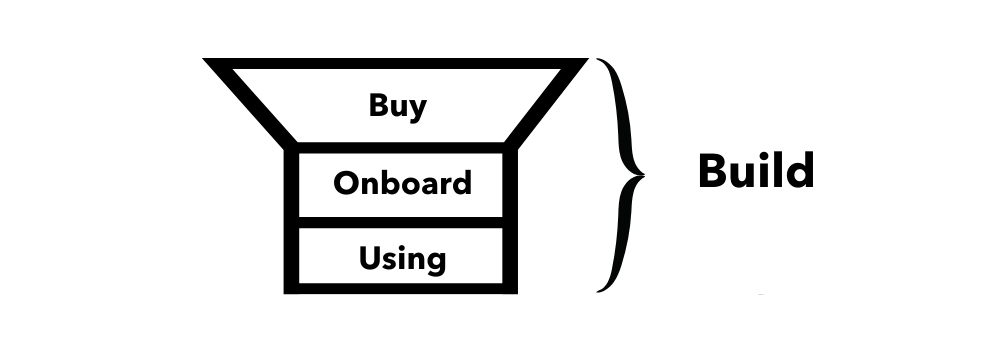Parts of the Build Stage
The build stage starts off with the first goal of Story Funnel which is to get a prospect to buy. Once we get our new customers, we want our interaction with them to be stellar

The build stage starts off with the first goal of Story Funnel which is to get a prospect to buy. Once we get our new customers, we want our interaction with them to be stellar -- not only for them but for your support team. It will be one of the hardest challenges of the Story Funnel to convert all those prospects to customers. As we will see later on, the first interactions with a new customer can make or break the rest of the funnel.
This is why we’ll pay attention to the first signs of stress and strain on a customer as they navigate this part of the funnel. Before we get into that, let’s discuss two more heuristics that we find useful in building our Story Funnel. The first, A Factor of 10 and 2, is an important one to determine the guardrails of your funnel and how well it’s performing. It also leads in nicely to the second one, which is the ever-popular 80/20 rule.
A Factor of 10 and 2
The factor of 10 into heuristic is all about the fallout at each of the stages. As a baseline, as you go through the final the number of people in it should drop by a factor of 10 or divide by 10 for the next stage will be only 10% of the last stage.
Conversely, the factor of two means that the best you could ever do at each stage would be to divide the last stage by two, or 50% goes on to the next stage. Now the reason why this is a good heuristic to follow is that its list size-independent.
It also is the lower and upper guard rail for your performance. If you have less than 10% going onto the next stage, then either your list is too big or you’re messaging wrong.
If you have more than 50% going onto the next stage, then your list is too narrow. All of this is to say that it’s important to have these guard rails in place so that you can get an intuitive sense of how you’re doing. Of course, the mileage may vary but if you are outside these guard rails chances are something is wrong.
As a general rule, most e-commerce conversion rates vary between 1% and at the best 5% if you’re someone like Gary Halbert. In terms of adding to a cart to check out, that’s roughly 50%. To add more context to this heuristic, the online encyclopedia, Wikipedia, has about a 2% donation rate from all the people who read it.
The 1% rule is also a variation on the factor of 10 and 2. It relates to the percentage of users that add content to a website, like Wikipedia. The rule is also known as the 90-9-1 rule or that 90% of people consume content (lurkers), 9% change or update content, and 1% add content.
These are good rules to know since it’s often hard to tell what’s working and what’s not. We’ll use variations of the Factor of 10 and 2 as our guardrails for figuring out how well our Story Funnel is performing. It can be hard to know what’s working and what’s not and that’s why we need another heuristic to help us out -- the 80/20 rule.
80/20 Rule
The 80/20 rule or Pareto Principle is a power-law distribution that many natural phenomena adhere to. Simply stated, the 80/20 states that for many outcomes, roughly 80% of consequences come from 20% of the causes. A common business adage is that "80% of sales come from 20% of clients.” For the Story Funnel, we’ll be using this to determine which causes (messaging) produces the consequences (outcomes) we want.
It’s important to know that not everything you will do will work. Our whole goal here at the Story Funnel is to build a framework that allows you to experiment all while keeping your story straight. It’s vital to have a top-level strategy for your brand’s story so that when the whacky ideas flow, you can apply some sort of filter to them. Now, back to the 80/20 rule.
The 80/20 rule will be a powerful ally in how many experiments you’ll need to run and overall success metrics. As an example, if 80% of the outcomes come from 20% of your ideas, then you’ll need at least five ideas to get one good one that makes a difference.
At times, this can be frustrating since statistics being what they are, you could hit on idea 1 or idea 10, or even idea 100. Well, probably not 100 but chances are, it will take more than five ideas to hit on one that works. That’s why we want to build our Story Funnel strategy ahead of time so that we have the best shot at hitting on a good idea.
We know from experience that if the overall story arch is sound, then that’s the hard part. The reason being that if you waste time and effort on ads and stories that are off-brand, it will reduce your chances of success. This does not mean you don’t try some wacky ideas every once in a while but the majority of your creative energy should be spent on brand and on your story.
The First Goal of Story Funnel
As we mentioned before, the first goal of Story Funnel is to get as many prospects to purchase your offering as possible. The transition from Hook to Build is also the leakiest part of the whole funnel.
Stage 4 -- Buying or Build ToFu
The buying stage is when a prospect puts down their hard-earned money and buys something from you. In our opinion, a free subscription or tier of service is not considered a customer, so we won’t count them.
Buying is the first goal of building a Story Funnel. It’s the ultimate signal that your product or service is desirable to someone and also is hitting Product Market Fit (PMF). In terms of Time on Target (ToT), the buying journey or time to buy should be quick -- not more than 5 minutes. This can depend on the price of the product or service but in general, the friction to buy should be as low as possible. This would even include getting quotes and PO’s.
Metrics to Track
There is really only one metric to track at this stage and that’s purchases. We put down some others to show purchase intent but purchase is the best one. You’ll also see that the Add to Cart metric spills over from Hook. This is normal.
- Purchases
- Free to Paid
- Free Tier Signups
- Add to Cart
- Returns or Refunds
Stage 5 -- Onboarding or Build MoFu
Onboarding is when your now new customer first interacts with your product or service. This is the first and most important step in the customer journey to an advocate.
Onboarding is product or service dependent. For each one, you’ll have to sort out what’s the most critical part of your onboarding process. We’ll talk more about those types of things in the conventions and requirements as well as the structure of the offering. For now, the metrics will be general in terms of when new customers can use your products or services.
Metrics to Track
Onboarding metrics relate to the first critical interactions with your new customer. It’s essential to make this as smooth as possible. These first moments with your brand will cast a long shadow.
- Sign In or Setup
- Finishing their Profile
- Login in Streak (days in a row)
- Product Shipped
- Product Delivered or Downloaded
- Customer Service emails or class about the setup.
- Chat Sessions with set up questions
- Customer Service Satisfaction
- Issue resolution time
Stage 6 -- Using or Build BoFu
Using your product is the first setup in getting a customer productive, which is the ToFu for the Payoff phase. In order to get customers using your offering, it has to do the job that they bought it for. If it does not deliver, then your new customers will no longer use it or even return it.
Using metrics can get skewed when it comes to free plans or tiers. That’s why we really don’t recommend calling those on your free tier a customer. If you do, then it’s best to separate out your free and paid tiers to see what’s what. We have included a metric from free to pay for this stage of the funnel if that’s your business model.
Metrics to Track
- Daily Active Users (DAU)
- 7-Day Retention
- 14-Day Retention
- 30-Day Retention
- Last Login
- Customer Service Questions
- Free to Paid Conversion
- Upgrade (if offered)
- Customer Churn
Exiting the Build Stage
The build stage is exited when a customer cancels their subscription or returns their product. We also consider a downgrade to a free plan as an exit from this stage but not a hard exit. Rather, a way for the “customer” to always stay in the build stage. Let’s clarify that a bit.
A “customer” on a free plan can never leave the build stage. We don’t consider a “customer” that does not pay for a product or service on the path to an advocate. This is an important idea to grasp so that the metrics leading into the next stage are not inflated. It’s fine to track those on your free tier or ones that have been downgraded (which can be an exit from the payoff stage back to the build stage). What we want to achieve is a realistic view of the health of each stage so we can take action.
You may want to consider a free tier as an exit from this stage back to Hook but we’ll leave that up to you to decide. In general, how you set up your Story Funnel is up to you since the goal is to understand your entire sales, marketing, and retention process.
The positive exit from the build stage is a productive customer that’s primed to help you promote your brand.
Implementing the Build Stage
The build stage requires a way for prospects to purchase and receive products or services. It also requires some sort of customer service portal or team to answer questions. During this stage, we want to ensure that we deliver on the promise that we made during the hook stage.
The amount of energy and time spent here can never be underestimated. We want our new customers to have the most pleasant experience they can get while using and interacting with our offering. It’s vital that they don’t feel abandoned or not supported.
Next up, we’ll work on the final stage of the Story Funnel -- Paying Off Advocates. This stage is the most important for continued success because it’s advocates (happy customers) that will sell your offerings for you. Of course they will need some help and it’s this stage that turns a normal customer into an advocate so both of you benefit.
Are you ready to pay off advocates by making them feel special?

